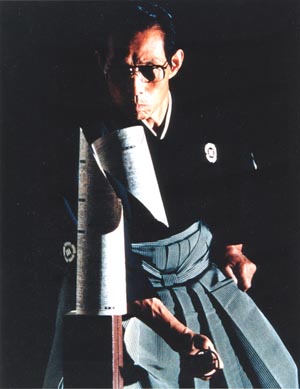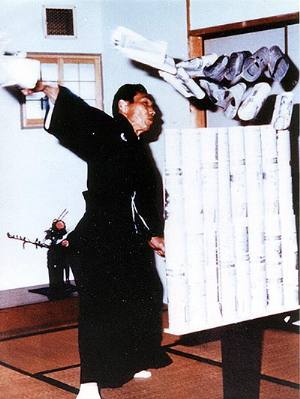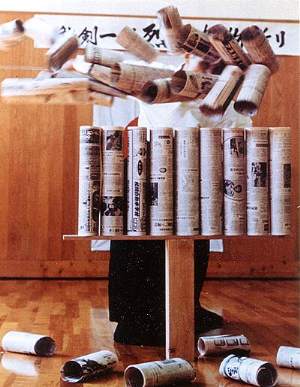

Copyright
Kim Taylor © 2001. All rights reserved.
The following is an interview with Miura Hidefusa sensei,
the headmaster of the Jikishinkai. It was conducted by email and regular
mail through professional translators May to June 2001.
With regard to your initial questions, here is my personal history.
My name is Miura Takeyuki (Hidefusa is my kenshi name.)
I was born on the 11th year of the Taisho era on January the 5th (1922) in the prefecture of Shimane. My family is from the Fujiwara Ason Sakyonnosuke (Fujiwara Michinaga) bloodline we are of the 35th generation of this bloodline. The family line of Fujiwara Michinaga is a shinto priest lineage. Now as a shinto priest myself I work on the grounds of Yasaka shrine in Neyagawa-shi Osaka. On the 50th year of the Showa era on June 8th (1975). I founded the Nippon Kobudo Jikishin Kai. As the president of this organization I value our ancestral ways.
Inside our organization we practice sword arts (iaijutsu, kenjutsu, suemonogiri), jojutsu and jujutsu. On the first year of the Heisei era we built the Jikishin Kan dojo on the grounds of Yasaka shrine. We put strong emphasis on continuous practice in order to improve our total ability and better understand the true essence of kobudo, to improve our daily lives and the world around us, as well as continuing our ancestral ways. This is our ultimate goal.
On the first year of the Heisei era the Dai Nippon Butoku Kai appointed me as the chief official on the senior board of examination. On the 6th year of the Heisei era (1994) I was appointed to the title of sub director of the Dai Nippon Butoku Kai.
Martial curriculum.
Can you tell us a bit about your training please?
On the 8th year of the Showa era (1933). When I was 11 years old I was studying kendo under Ishitobi sensei who graduated from the Budo senmon gakko. During the wartime I studied Jukendo. On the 34th year of the Showa era (1959) after the war we where allowed to practice budo again. In Osaka Narusei Sakahiro was the president (Hanshi) of the Kendo Renmei Yaegaki Kai and I started iaido with Narusei Sakahiro. At the same time Narisei sensei gave me the chance to meet Masaoka Kazumi a direct student of Oe Masamichi and I received instruction in koryu from him. This is how I started Eishin ryu.
On the the 35th year of the showa era (1960) I started Shindo Muso ryu jojutsu with Nakajima Asakichi who was a direct and personal student of Shimizu Takatsugu. On the 40th year of the showa era (1965) I learned Enshin ryu Iai Suemonogiri Kenpo from the 3rd soke Kobashi Nikkan. On the 44th (1969) year of the Showa era when the Kendo Renmei made the Seitei Iai, I was chosen to be the representative for the Osaka region. I practiced and taught Seitei Iai in Osaka.
From the 45th (1970) year of the Showa era, I chose to concentrate on koryu only . I then taught only Eishin ryu, while in the same year I studied Kukishin ryu bojutsu under the 11th headmaster of the ryu Kano Takehiko. On the 48th year (1973) of the Showa era I received 8th dan from the Zen Nippon Kobudo Sogo Renmei. On the (1976) 51st year of the Showa era I received the title of hanshi from the Zen Nippon Kobudo Sogo Renmei. On the 52nd year (1977) of Showa I received from the Toyama Ryu, the title of hanshi 8th dan. On the 59th (1984) Showa I received the title of hanshi 8th dan from the Dai Nippon Butoku Kai in Kyoto. On the 5th year of the Heisei era (1993) I received 9 dan from Dai Nippon Butoku Kai.
The main purpose within our ryu, the Seito Muso Jikiden Eishin Ryu Iai Heiho, for achieving mastery of the koryu, is to train very hard (Shugyo) in order to be able to answer any type of threat. In order to understand martial arts (Bugei) at our dojo we also teach Shinto Muso ryu Jojutsu and Yanagi ryu Jujutsu as well.
Which organization does your dojo currently belong to?
Our dojo Belongs to the Dai Nippon Butoku Kai and the Nippon Kobudo Shinko Kai. We do not belong to any other federation or organization. As kaicho of the Nippon Kobudo Jikishin Kai I issue gradings from within the dojo to our own students. Also, our students that are members of the Dai Nippon Butoku Kai can be graded upon my recommendation to that group.
Do you still teach the ZNKR iai set in your organization?
Inside our organization we only teach and practice koryu. We do not teach or practice the iai kata from the Zen Nippon Kendo Renmei, but in the past, 23 years ago, we used to teach Seitei Iai.
How is your organization set up?
The head dojo of our organization (Hombu) is in Neyagawa-Shi (Osaka) Japan. At the present moment we have only two branches outside of Japan which are two separate entities. The United States of America is headed by Shimabukuro Masayuki. In Canada the branch is headed by Kinoshita Kuniko.
Those two branches, which where authorized by myself, have the responsibility to manage their own organization in all aspects. If any of those two branches wishes to expand internationally it is the choice of the branch chief itself and not the hombu dojo in Japan. Now at the hombu dojo in Japan we have many foreigners living in Japan that are practicing Iaido with us. When they go back to their country they might also be allowed to open their own dojo, so because we have more international students no precise boundaries were set for the two existing branches.

Our Lineage
In Muso Jikiden Eishin ryu iaijutsu.
Founder- Hayashizaki Jinsuke Shigenobu
2nd Tamiya Heibei
Shigemasa
3rd Nagano
Muraku Nyudo Kinrosai
4th Momo
Gumbei Mitsushige
5th Arikawa
Shozaemon Munetsugu
6th Banno
Danoemon no Jo Nobusada
7th Hasegawa
Chikaranosuke Eishin Hidenobu
8th Arai
Seitetsu Kiyonobu
9th Hayashi
Rokudayu Morimasa
10th Hayashi Yasudayu
Seisho
11th Oguro Motoemon
Kiyokatsu
12th Hayashi Masu (Masa)
no Jo Masanari (Seishi)
13th Yoda (Manzai)
(Manzo ; Sanasho) Yorikatsu
14th Hayashi Yadayu
(Seiki) Masayori (Masataka)
15th Tanimura Kame
no Jo Yorikatsu (Sugio)
16th Goto Magobei Masasuke
(Seiryo)
17th Oe Masamichi (Shikei)
18th Masaoka Kasumi
19th Narisei Sakahiro
20th Miura Takeyuki
Hidefusa
Have you selected a successor to your lineage yet?
As far as my successor, nobody has been selected yet. When I have made a decision a formal announcement will be made.
Could you comment on the kata of the MJER with particular reference to those practiced in your school please?
Oe Masamichi lived at the time of the Meiji restoration when the haitorei (the ban on the wearing of the sword) was implemented, therefore creating a very big obstacle to the continuation of iai. Oe sensei rearranged Eishin ryu in order to expose this tradition to a wider audience and preserve it as well. These are the waza that are now practiced in Seito Muso Jikiden Eishin Ryu today.
Seiza no bu 11 kata
1- Mae
2- Migi
3- Hidari
4- Ushiro
5- Yaegaki
6- Ukenagashi
7- Kaishaku
8- Tsukekomi
9- Tsukikage
10- Oikaze
11- Nukiuchi
Tatehiza no bu 10 kata
Yokogumo
Tora no Issoku
Inazuma
Yukigumo
Oroshi
Iwanami
Urokugaeshi
Namigaeshi
Takiotoshi
Makko
Okuiai Iwaza 8 kata
Kazumi
Sunegakoi
Tozume
Towaki
Shiogiri
Tanashita
Ryozume
Torabashiri
Okuiai Tachiwaza 13 kata
Yukizure
Tsuredachi
Sommakuri
Sodome
Shinobu
Yukichigai
Sodesoregeashi
Moniri
Kabezoe
Ukenagashi
Itomagoi1
Itomagoi2
Itomagoi3
Tachi uchi no kurai 7 kata
1- Deai
2- Kobushitori
3- Zetsumyoken
4- Dokumyoken
5- Tsuba dome
6- Ukenagashi
7- Makko
Could you outline the reason why we should study the sword arts?
Since ancient times the existence of budo has depended on one ultimate
state, of killing or being killed in a combat situation. In order to face
critical situations such as battlefields or duels the proper training of
the body and spirit would enable a sincere practitioner to be able to face
such
critical situations.

Sensei could you tell us how you perform those cuts on newspaper? Is your sword a special shape or is it polished in a special way?
Now as far as using a special sword or special way of polishing to do
the newspaper cut there is nothing other than perfect technique.